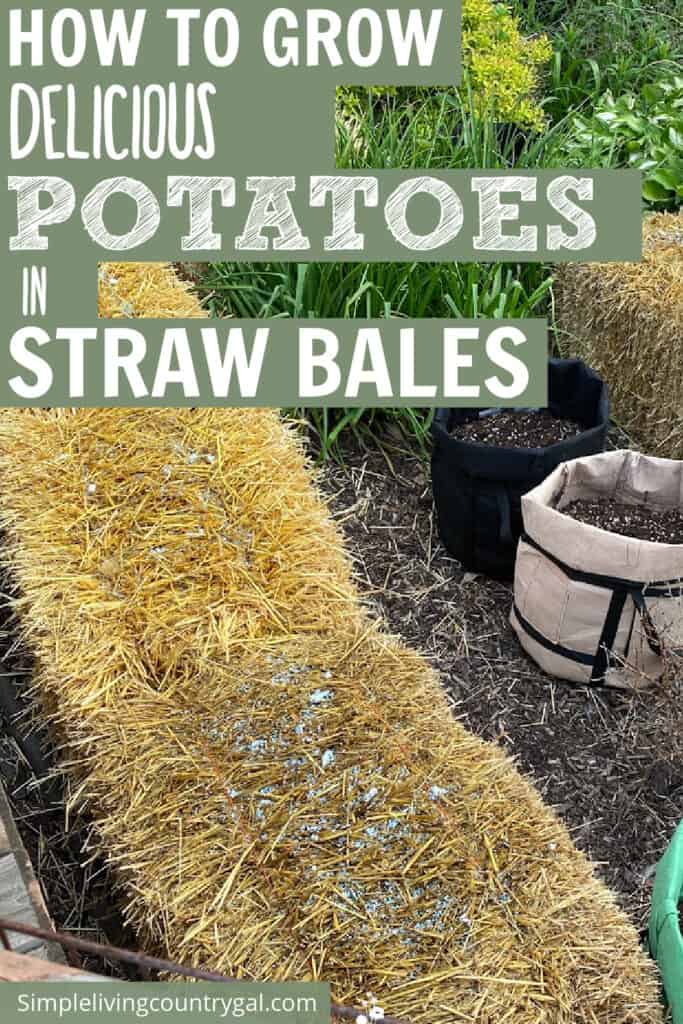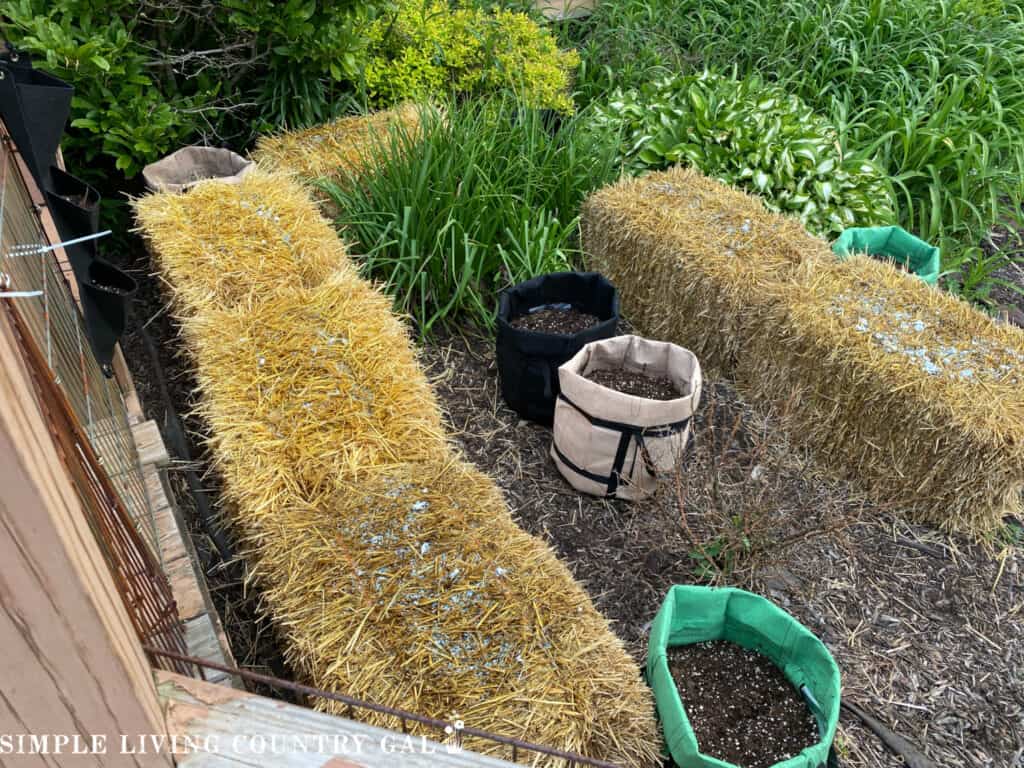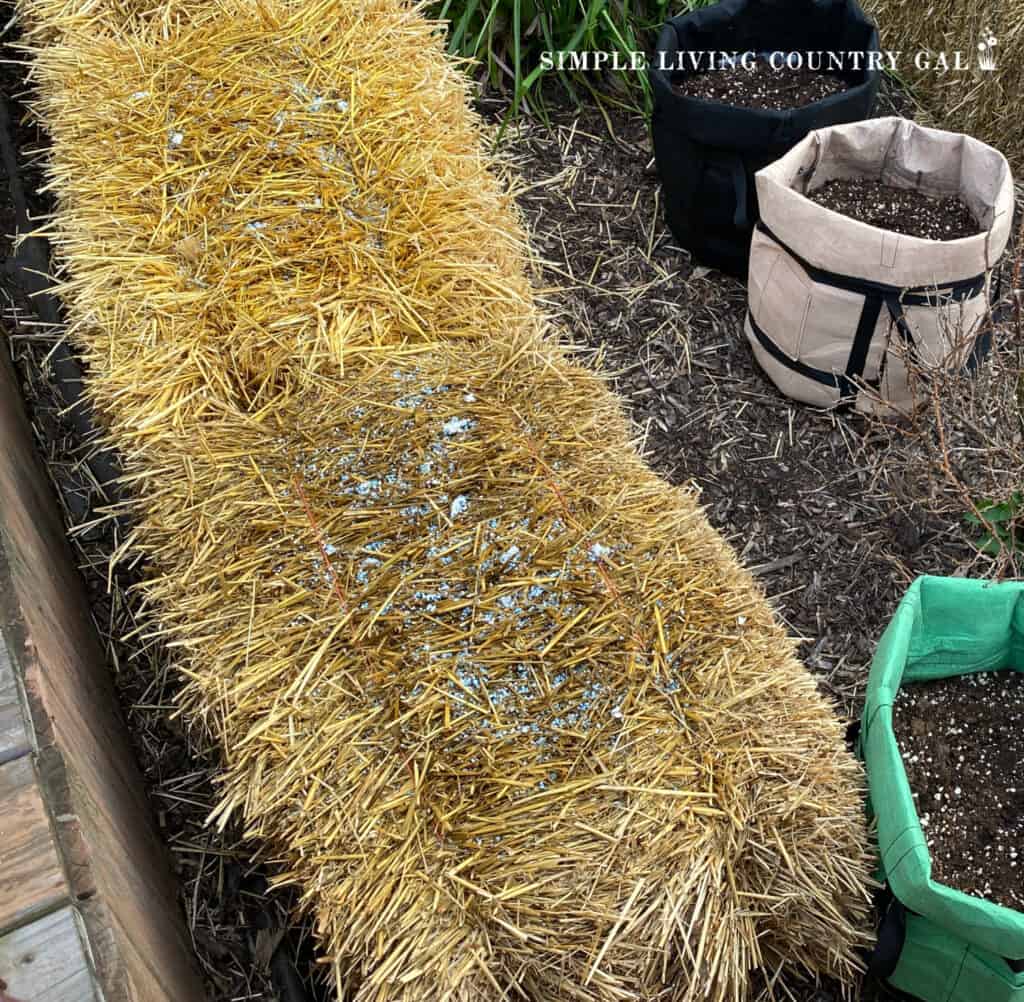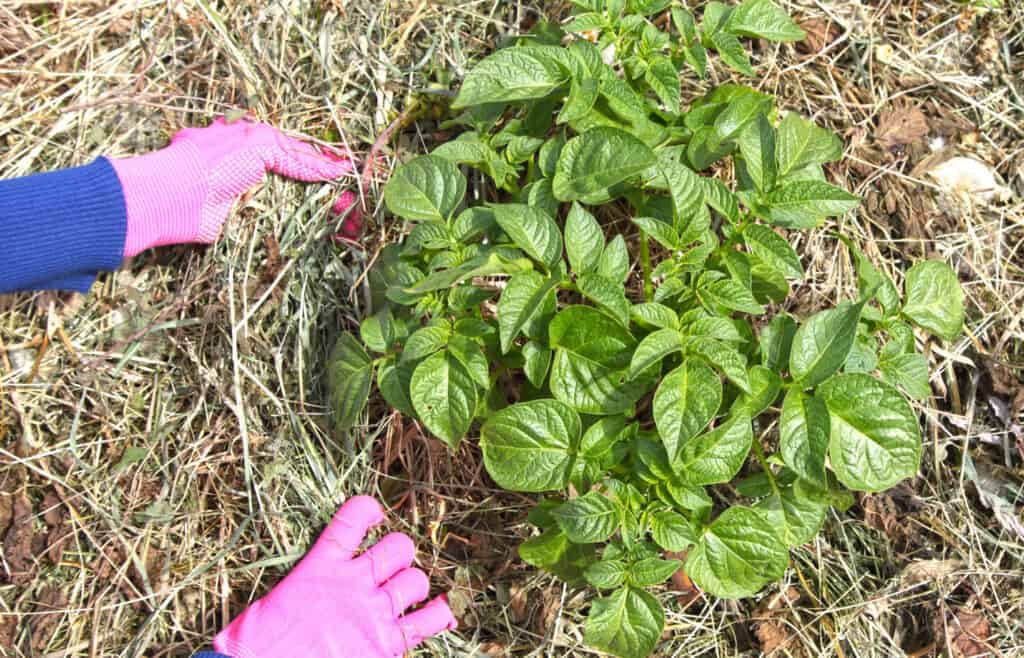Growing Potatoes in Straw Bales
Growing potatoes in straw bales is a great way to garden without going all in with a traditional setup. Bales are an easier way to grow the food you enjoy when you are short on time or energy.
Gardening 101 tips that will help you set up a flourishing straw bale set up in your own backyard.

What is straw bale gardening?
Straw bale gardening is a method of gardening that completely bypasses the need for a traditional backyard setup. Instead, plants are grown directly in bales of straw, allowing you to grow your food even if you are short on space, have poor-quality soil, or have physical limitations.
The straw bales are prepped in a way that quickens the decomposition of the interior, making it a rich and fertile medium for plants to grow. This method also keeps the roots out of the ground, reducing common issues such as soil-borne diseases and pests. Straw bale gardening is gaining popularity because it works in so many situations.
Related: How to Grow Tomatoes in Straw Bales
What are the benefits of straw bale gardening for growing potatoes?
Straw bale gardening is a great way to grow potatoes for many reasons.
- It eliminates the need for digging.
- The straw bale provides an elevated platform, reducing the physical strain of planting and harvesting.
- The straw creates a loose, well-drained environment that potatoes love.
- It reduces the risk of rot due to water-logged soil, a common issue when growing potatoes in traditional gardens.
- The straw also acts as a natural barrier, protecting the potatoes from pests and diseases that usually lurk in the soil.
- Straw bale gardening is a sustainable method as the straw decomposes over time, making it a great addition to your compost area.

What are the materials needed for growing potatoes in bales of straw?
To start growing potatoes in bales of straw, you will need the following materials:
- Straw Bales: Depending on the number of potatoes you plan to grow, you may need multiple bales. It’s important to ensure that the straw is untreated and free of seeds to prevent weed growth.
- Seed Potatoes: Choose certified seed potatoes to ensure they are disease-free. You can find potatoes for planting at any store or online.
- Fertilizer: Fertilizer is essential for preparing the straw bales by composting down the interior area, making it suitable for growing potatoes.
- Water: Regular watering is part of the conditioning phase of the straw bales. You will also need to water once the potatoes are planted, like in a traditional garden.
- Tarp or Plastic Sheeting (Optional): You can put a tarp under each bale to keep it better contained making it easier to clean up at the end of the growing season.
- Gardening Gloves: For protection and comfort while handling straw bales and planting.
- Fertilizer after planting(Optional): While not absolutely necessary, adding a balanced fertilizer can boost the nutrient content in your straw bales, promoting better potato growth.
Planting the Potatoes
Planting potatoes in straw bales is similar to traditional planting, with a few exceptions. Let’s break it down step-by-step.
#1. Condition the Bales
First, you will need to condition the bales, which takes a few weeks to complete. Look to see when the panting time is in your area and start the bale prep 2-3 weeks prior.
READ: How to Prepare Straw Bales for Planting

#2. Prepare the Seed Potatoes
While your bales are conditioning, prepare your seed potatoes. Cut larger potatoes into pieces, each with at least one ‘eye.’ Leave small potatoes whole. Allow them to dry out for a few days before planting to prevent rot.
#3. Plant the Potatoes
Once your bales are conditioned, create pockets in the straw about 6 inches deep. You can add a handful or two of potting soil, but it isn’t necessary. Next, place a potato piece in each pocket with the eyes facing up. Space the pockets about 12 inches apart to give the plants room to grow. You should be able to plant and grow four potato plants in one regular-sized straw bale.
Straw Bale Supplies:
Potato Seeds for Planting Outdoors, 70 Yukon Gold True Potato Seeds Heirloom Seeds



When is the best time to plant potatoes?
The best time to plant potatoes varies based on your location and the variety of potatoes, but generally, potatoes are planted in the early spring. In cooler climates, you’ll want to plant them as soon as the soil has thawed and can be worked – typically late March to early April. In warmer climates, potatoes can often be planted in the late winter or early spring.
Remember that potatoes are a cool-weather crop and can tolerate a light frost, but you should aim to have them fully grown before hot summer temperatures kick in.
#4. Cover and Water
Once planted, close the pocket up and water thoroughly. Continue to water regularly, keeping the bales moist but not waterlogged.
#5. Wait and Watch
The potatoes will start to sprout in a few weeks. Add more straw or potting soil around the growing plants to keep the developing potatoes covered.

#6. Harvest
When the foliage has died back, your potatoes are ready to harvest. Pull apart the straw bale until you find your newly grown potatoes. Be sure to remove the excess soil and store them in a cool, dry area.
How do you harvest without damaging the potatoes?
Harvesting potatoes without causing damage requires a gentle touch and a bit of patience. Start by carefully pulling apart the straw bale, doing your best to avoid pulling directly on the plant stems. Use your hands to gently sift through the straw and soil, feeling for the potatoes. Try not to use a tool unless absolutely necessary, as this might accidentally cut into the potatoes.
When you’ve located a potato, gently ease it out of the bale. Make sure to handle the freshly harvested potatoes carefully to prevent bruising. Lastly, remember that potatoes left in the ground after the plant’s foliage has died back can suffer from rot, so it’s essential to harvest them all promptly.
I love straw bale gardening because it allows me to grow my own food, even with my physical limitations. By following these simple steps, you can enjoy fresh organic potatoes with this easier way to garden.
Easier to prep, plant, grow, and harvest, making this gardening method a popular choice for all kinds of home gardeners. Give it a try, and you might be surprised by how effective and easy it is!
More Straw Bale Resources:
- Best Plants for Straw Bale Gardening
- Straw Bale Gardening for Beginners
- Growing Tomatoes in Straw Bales





